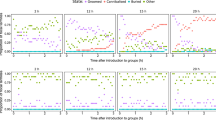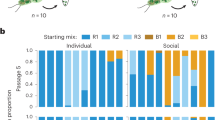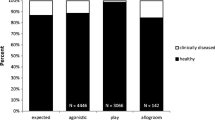Abstract
Individuals within animal societies are expected to mitigate the costs and enhance the benefits associated with group living. For example, sociality can facilitate the sharing of beneficial microbes among individuals, but can also increase transmission of pathogens, representing a major cost of group living. We examined the costs of sociality in the California slender salamander (Batrachoseps attenuatus), a terrestrial salamander which naturally forms close social aggregations. We investigated whether innate sociality (e.g., skin-to-skin contact) increases an individual’s transmission risk of Batrachochytrium dendrobatidis (Bd), a fungal pathogen that emerged throughout the salamander’s range over the last 50 years and has decimated hundreds of amphibian species globally. We found that in captivity, B. attenuatus exhibit random mixing within social groups, resulting in high contact rates and high potential for Bd transmission. Our experimental infection trials resulted in 50% mortality after 1 month in moist conditions. In order to test how group size affects pathogen transmission, we manipulated social group size and found a marked effect on the spread Bd among individuals; a single, uninfected individual contracted Bd much more rapidly in larger groups of infected individuals. Surprisingly, this did not translate into a more rapid death rate or higher pathogen infection loads. Our results show that the innate behavior of group formation represents a per-individual risk of socially acquired pathogens, with direct transmission being magnified in larger social groups. This study highlights one important cost of sociality in terrestrial salamanders and underscores the general susceptibility of social animals to novel invasive pathogens.
Significance statement
Social behaviors typically evolve due to the benefits of associating with others, but they can also present risks such as disease transmission. The California slender salamander is highly social, with individuals forming close aggregations underneath cover items. Populations of this species have recently been discovered to suffer from the widespread and deadly fungal pathogen Batrachochytrium dendrobatidis (Bd) which is transmitted through aquatic zoospores. Because this salamander host species is fully terrestrial, we set out to determine if close aggregations (leading to skin-to-skin contact) provide opportunities for direct transmission of Bd. Infection trials in larger social groups revealed a more rapid spread of Bd; however, we did not witness more rapid death rates or ultimately higher pathogen infection loads. Our results show that the social behavior of these salamanders leads to a higher probability of acquiring Bd, highlighting the complex effects that emergent pathogens may have on social species.




Similar content being viewed by others
Data availability
All data are on Dryad (https://doi.org/10.5061/dryad.9cnp5hqj5).
Code availability
R code is available in Dryad (https://doi.org/10.5061/dryad.9cnp5hqj5).
References
Altizer S, Nunn CL, Thrall PH et al (2003) Social organization and parasite risk in mammals: integrating theory and empirical studies. Annu Rev Ecol Evol S 34:517–547. https://doi.org/10.1146/annurev.ecolsys.34.030102.151725
Araujo A, Kirschman L, Warne RW (2016) Behavioural phenotypes predict disease susceptibility and infectiousness. Biol Lett 12:20160480. https://doi.org/10.1098/rsbl.2016.0480
Bancroft BA, Han BA, Searle CL, Biga LM, Olson DH, Kats LB, Lawler JJ, Blaustein AR (2011) Species-level correlates of susceptibility to the pathogenic amphibian fungus Batrachochytrium dendrobatidis in the United States. Biodivers Conserv 20:1911–1920. https://doi.org/10.1007/s10531-011-0066-4
Barnosky AD, Matzke N, Tomiya S et al (2011) Has the earth’s sixth mass extinction already arrived? Nature 471:51–57. https://doi.org/10.1038/nature09678
Berger L, Hyatt AD, Speare R, Longcore JE (2005) Life cycle stages of the amphibian chytrid Batrachochytrium dendrobatidis. Dis Aquat Org 68:51–63. https://doi.org/10.3354/dao068051
Blaustein AR, Han BA, Relyea RA, Johnson PTJ, Buck JC, Gervasi SS, Kats LB (2011) The complexity of amphibian population declines: understanding the role of cofactors in driving amphibian losses. Ann NY Acad Sci 122:108–119. https://doi.org/10.1111/j.1749-6632.2010.05909.x
Blehert DS, Hicks AC, Behr M et al (2009) Bat white-nose syndrome: an emerging fungal pathogen? Science 323:227. https://doi.org/10.1126/science.1163874
Boots M, Mealor M (2007) Local interactions select for lower pathogen infectivity. Science 315:1284–1286. https://doi.org/10.1126/science.1137126
Boyle DG, Boyle DB, Olsen V, Morgan JAT, Hyatt AD (2004) Rapid quantitative detection of chytridiomycosis (Batrachochytrium dendrobatidis) in amphibian samples using real-time Taqman PCR assay. Dis Aquat Org 60:141–148. https://doi.org/10.3354/dao060141
Bradford DF (1984) Temperature modulation in a high-elevation amphibian, Rana muscosa. Copeia 1984:966–976. https://doi.org/10.2307/1445341
Briggs CJ, Knapp RA, Vredenburg VT (2010) Enzootic and epizootic dynamics of the chytrid fungal pathogen of amphibians. P Natl Acad Sci USA 107:9695–9700. https://doi.org/10.1073/pnas.0912886107
Brown CR, Brown M (1996) Coloniality in the cliff swallow: the effect of group size on social behavior. University of Chicago, Chicago
Cameron SA, Lozier JD, Strange JP, Koch JB, Cordes N, Solter LF, Griswold TL (2011) Patterns of widespread decline in North American bumble bees. P Natl Acad Sci USA 102:662–667. https://doi.org/10.1073/pnas.1014743108
Chaukulkar S, Sulaeman H, Zink AG, Vredenburg VT (2018) Pathogen invasion and non-epizootic dynamics in Pacific newts in California over the last century. PLoS ONE 13:e0197710. https://doi.org/10.1371/journal.pone.0197710
Cheng TL, Rovito SM, Wake DB, Vredenburg VT (2011) Coincident mass extirpation of neotropical amphibians with the emergence of the infectious fungal pathogen Batrachochytrium dendrobatidis. P Natl Acad Sci USA 108:9502–9507. https://doi.org/10.1073/pnas.1105538108
Côté IM, Poulin R (1995) Parasitism and group size in social animals: a meta-analysis. Behav Ecol 6:159–165. https://doi.org/10.1093/beheco/6.2.159
Dolan TW, Butler MJ, Shields JD (2014) Host behavior alters spiny lobster-viral disease dynamics: a simulation study. Ecology 95:2346–2361. https://doi.org/10.1890/13-0118.1
Eskew EA, Todd BD (2013) Parallels in amphibian and bat declines from pathogenic fungi. Emerg Infect Dis 19:379–385. https://doi.org/10.3201/eid1903.120707
Ezenwa VO (2004) Host social behavior and parasitic infection: a multifactorial approach. Behav Ecol 15:446–454. https://doi.org/10.1093/beheco/arh028
Ezenwa VO, Archie EA, Craft ME, Hawley DM, Martin LB, Moore J, White L (2016a) Host behavior – parasite feedback: an essential link between animal behaviour and disease ecology. Proc R Soc B 283:20153078. https://doi.org/10.1098/rspb.2015.3078
Ezenwa VO, Ghai RR, McKay AG, Williams AE (2016b) Group living and pathogen infection revisited. Curr Opin Behav Sci 12:66–72. https://doi.org/10.1016/j.cobeha.2016.09.006
Frank S (1994) The genetics of mutualism: the evolution of altruism between species. J Theor Biol 170:393–400. https://doi.org/10.1006/jtbi.1994.1200
Frick WF, Pollock JF, Hicks AC, Langwig KE, Reynolds DS, Turner GG, Butchkoski CM, Kunz TH (2010) An emerging disease causes regional population collapse of a common North American bat species. Science 329:679–682. https://doi.org/10.1126/science.1188594
Grear DA, Luong LT, Hudson PJ (2013) Network transmission inference host behavior and parasite life cycle make social networks meaningful in disease ecology. Ecol Appl 23:1906–1914. https://doi.org/10.1890/13-0907.1
Hamede RK, Bashford J, McCallum H, Jones M (2009) Contact networks in a wild Tasmanian devil (Sarcophilus harrisii) population: using social network analysis to reveal seasonal variability in social behaviour and its implications for transmission of devil facial tumor disease. Ecol Lett 12:1147–1157. https://doi.org/10.1111/j.1461-0248.2009.01370.x
Han BA, Bradley PW, Blaustein AR (2008) Ancient behaviors of larval amphibians in response to an emerging fungal pathogen, Batrachochytium dendrobatidis. Behav Ecol Sociobiol 63:241–250. https://doi.org/10.1007/s00265-008-0655-8
Han BA, Park AW, Jolles AE, Altizer S (2015) Infectious disease transmission and behavioural allometry in wild animals. J Animal Ecol 84:637–646. https://doi.org/10.1111/1365-2656.12336
Harris RN, Hames WW, Knight IT, Carreno CA, Vess TJ (1995) An experimental analysis of joint nesting in the salamander Hemidaetylium scutatum (Caudata: Plethodontidae): the effects of population density. Anim Behav 50:1309–1316. https://doi.org/10.1016/0003-3472(95)80046-8
Harris RN, James TY, Lauer A, Simon MA, Patel A (2006) The amphibian pathogen Batrachochytrium dendrobatidis is inhibited by the cutaneous bacteria of amphibian species. EcoHealth 3:53–56. https://doi.org/10.1007/s10393-005-0009-1
Hendrickson JR (1954) Ecology and systematics of salamanders of the genus Batrachoseps. Univ Calif Publ Zool 54:1–45
Hewson I, Button JB, Gudenkauf BM et al (2014) Densovirus associated with sea-star wasting disease and mass mortality. P Natl Acad Sci USA 111:17278–17283. https://doi.org/10.1073/pnas.1416625111
Hoverman JT, Searle CL (2016) Behavioral influences on disease risk: implications for conservation and management. Anim Behav 120:263–271. https://doi.org/10.1016/j.anbehav.2016.05.013
Hyatt AD, Boyle DG, Olsen V et al (2007) Diagnostic assays and sampling protocols for the detection of Batrachochytrium dendrobatidis. Dis Aquat Org 73:175–192. https://doi.org/10.3354/dao073175
Jaeger RG, Forester DC (1993) Social behavior of plethodontid salamanders. Herpetologica 49:163–175
James TY, Toledo LF, Rödder D et al (2015) Disentangling host, pathogen, and environmental determinants of a recently emerged wildlife disease: lessons from the first 15 years of amphibian chytridiomycosis research. Ecol Evol 5:4079–4097. https://doi.org/10.1002/ece3.1672
Jockusch EL, Hansen RW, Fisher RN, Wake DB (2020) Slender salamanders (genus Batrachoseps) reveal Southern California to be a center for the diversification, persistence, and introduction of salamander lineages. PeerJ 8:e9599. https://doi.org/10.7717/peerj.9599
Jockusch EL, Mahoney MJ (1997) Communal oviposition and lack of parental care in Batrachoseps nigriventris (Caudata: Plethodontidae) with a discussion of the evolution of breeding behavior in plethodontid salamanders. Copeia 1997:697–705. https://doi.org/10.2307/1447288
Jockusch EL, Wake DB (2002) Falling apart and merging: diversification of slender salamanders (Plethodontidae: Batrachoseps) in the American West. Biol J Linn Soc 76:361–391. https://doi.org/10.1046/j.1095-8312.2002.00071.x
Kappeler PM, Cremer S, Nunn CL (2015) Sociality and health: impacts of sociality on disease susceptibility and transmission in animal and human societies. Phil Trans R Soc B 370:20140116. https://doi.org/10.1098/rstb.2014.0116
Kim K, Harvell CD (2004) The rise and fall of a six-year coral-fungal epizootic. Am Nat 164:S52–S63. https://doi.org/10.1086/424609
Kolby JE, Ramirez SD, Berger L, Richards-Hrdlicka KL, Jocque M, Skerratt LF (2015) Terrestrial dispersal and potential environmental transmission of the amphibian chytrid fungus (Batrachochytrium dendrobatidis). PLoS ONE 10:e0125386. https://doi.org/10.1371/journal.pone.0125386
Koprivnikar J, Gibson CH, Redfern JC (2012) Infectious personalities: behavioural syndromes and disease risk in larval amphibians. Proc R Soc B 279:1544–1550. https://doi.org/10.1098/rspb.2011.2156
Langwig KE, Frick WF, Bried JT, Hicks AC, Kunz TH, Kilpatrick AM (2012) Sociality, density-dependence and microclimates determine the persistence of populations suffering from a novel fungal disease, white-nose syndrome. Ecol Lett 15:1050–1057. https://doi.org/10.1111/j.1461-0248.2012.01829.x
Lewin-Epstein O, Aharonov R, Hadany L (2017) Microbes can help explain the evolution of host altruism. Nat Commun 8:14040. https://doi.org/10.1038/ncomms14040
Lips KR, Brem F, Brenes R, Reeve JD, Alford RA, Voyles J, Carey C, Livo L, Pessier AP, Collins JP (2006) Emerging infectious disease and the loss of biodiversity in a neotropical amphibian community. P Natl Acad Sci USA 103:3165. https://doi.org/10.1073/pnas.0506889103
Lloyd-Smith JO, Cross PC, Briggs CJ, Daugherty M, Getz WM, Latto J, Sanchez MS, Smith AB, Swei A (2005a) Should we expect population thresholds for wildlife disease? Trends Ecol Evol 438:355–359. https://doi.org/10.1016/j.tree.2005.07.004
Lloyd-Smith JO, Schreiber SJ, Kopp PE, Getz WM (2005b) Superspreading and the effect of individual variation on disease emergence. Nature 438:355–359. https://doi.org/10.1038/nature04153
Lombardo MP (2008) Access to mutualistic endosymbiotic microbes: an underappreciated benefit of group living. Behav Ecol Sociobiol 62:479–497. https://doi.org/10.1007/s00265-007-0428-9
Longcore JE, Pessier AP, Nichols DK (1999) Batrachocytrium dendrobatidis gen. et sp. nov., a chytrid pathogenic to amphibians. Mycologia 91:219–227. https://doi.org/10.2307/3761366
Maiorana VC (1977) Observations of salamanders (Amphibia, Urodela, Plethodontidae) dying in the field. J Herpetol 11:1–5. https://doi.org/10.2307/1563284
Martel A, Spitzen-van der Sluijs A, Blooi M et al (2013) Batrachochytrium salamandrivorans sp. nov. causes lethal chytridiomycosis in amphibians. P Natl Acad Sci USA 110:15325–15329. https://doi.org/10.1073/pnas.1307356110
McCallum ML (2015) Vertebrate biodiversity losses point to a sixth mass extinction. Biodivers Conserv 24:2497–2519. https://doi.org/10.1007/s10531-015-0940-6
Miller JC (2009) Spread of infectious disease through clustered populations. J R Soc Interface 6:1121–1134. https://doi.org/10.1098/rsif.2008.0524
Morales MA (2000) Mechanisms and density dependence of benefit in an ant- membracid mutualism. Ecology 81:482–489. https://doi.org/10.2307/177441
Naug D (2008) Structure of the social network and its influence on transmission dynamics in a honeybee colony. Behav Ecol Sociobiol 62:1719–1725. https://doi.org/10.1007/s00265-008-0600-x
Nunn CL, Jordan F, McCabe CM, Verdolin JL, Fewell JH (2015) Infectious disease and group size: more than just a numbers game. Phil Trans R Soc B 370:20140111. https://doi.org/10.1098/rstb.2014.0111
Patterson JEH, Ruckstuhl KE (2013) Parasite infection and host group size: a meta-analytical review. Parasitology 140:803–813. https://doi.org/10.1017/S0031182012002259
Piotrowski JS, Annis SL, Longcore JE (2004) Physiology of Batrachochytrium dendrobatidis, a chytrid pathogen of amphibians. Mycologia 96:9–15. https://doi.org/10.2307/3761981
Reeder NMM, Pessier AP, Vredenburg VT (2012) A reservoir species for the emerging amphibian pathogen Batrachochytrium dendrobatidis thrives in a landscape decimated by disease. PLoS ONE 7:e33567. https://doi.org/10.1371/journal.pone.0033567
Rifkin JL, Nunn CL, Garamszegi LZ (2012) Do animals living in larger groups experience greater parasitism: a meta-analysis. Am Nat 180:70–82. https://doi.org/10.1086/666081
Rowley JJL, Alford RA (2007) Behaviour of Australian rainforest stream frogs may affect the transmission of chytridiomycosis. Dis Aquat Org 77:1–9. https://doi.org/10.3354/dao01830
Sah P, Mann J, Bansal S (2018) Disease implications of animal social network structure: a synthesis across social systems. J Anim Ecol 87:546–558. https://doi.org/10.1111/1365-2656.12786
Schmid-Hempel P (2017) Parasites and their social hosts. Trends Parasitol 33:453–462. https://doi.org/10.1016/j.pt.2017.01.003
Searle CL, Gervasi SS, Hua J, Hammond JI, Relyea RS, Olson DH, Blaustein AR (2011) Differential host susceptibility to Batrachochytrium dendrobatidis, an emerging amphibian pathogen. Conserv Biol 25:965–974. https://doi.org/10.1111/j.1523-1739.2011.01708.x
Sette CM, Vredenburg VT, Zink AG (2015) Reconstructing historical and contemporary disease dynamics: a case study using the California Slender Salamander. Biol Conserv 192:20–29. https://doi.org/10.1016/j.biocon.2015.08.039
Sette CM, Vredenburg VT, Zink AG (2020) Differences in fungal disease dynamics in co-occurring terrestrial and aquatic amphibians. EcoHealth 17:302–314. https://doi.org/10.1007/s10393-020-01501-z
Skerratt LF, Berger L, Speare R, Cashins S, McDonald KR, Phillott AD, Hines HB, Kenyon N (2007) Spread of chytridiomycosis has caused the rapid global decline and extinction of frogs. EcoHealth 4:125–134. https://doi.org/10.1007/s10393-007-0093-5
Vazquez VM, Rothermel BB, Pessier AP (2009) Experimental infection of North American Plethodontid salamanders with the fungus Batrachochytrium dendrobatidis. Dis Aquat Org 84:1–7. https://doi.org/10.3354/dao02026
Venesky MD, Kerby JL, Storfer A, Parris MJ (2011) Can differences in host behavior drive patterns of disease prevalence in tadpoles? PLoS ONE 6:e24991. https://doi.org/10.1371/journal.pone.0024991
Voyles J, Phillips A, Dreiessen M, Webb M, Berger L, Woodhams DC, Murray K, Skerratt LF (2014) Initial assessment of host susceptibility and pathogen virulence for conservation and management of Tasmanian amphibians. Herpetol Conserv Biol 9:106–115
Voyles J, Vredenburg VT, Tunstall TS, Parker JM, Briggs CJ, Rosenblum EB (2012) Pathophysiology in mountain yellow-legged frogs (Rana muscosa) during a chytridiomycosis outbreak. PLoS ONE 7:e35374. https://doi.org/10.1371/journal.pone.0035374
Voyles J, Young S, Berger L et al (2009) Pathogenesis of chytridiomycosis, a cause of catastrophic amphibian declines. Science 326:582–585. https://doi.org/10.1126/science.1176765
Vredenburg VT, Knapp RA, Tunstall TS, Briggs CJ (2010) Dynamics of an emerging disease drive large-scale amphibian population extinctions. P Natl Acad Sci USA 107:9689–9694. https://doi.org/10.1073/pnas.0914111107
Vredenburg VT, Briggs CJ, Harris RN (2011) Host-pathogen dynamics of amphibian chytridiomycosis: the role of the skin microbiome in health and disease. In: Olsen L, Choffnes ER, Relman DA, Pray L (eds) Fungal diseases: an emerging threat to human, animal and plant health. National Academies Press IOM (Institute of Medicine), Washington, DC, pp 342–355
Wake DB, Vredenburg VT (2008) Are we in the midst of the sixth mass extinction? A view from the world’s amphibians. P Natl Acad Sci USA 105:11466–11473. https://doi.org/10.1073/pnas.0801921105
Walke JB, Harris RN, Reinert LK, Rollins-Smith LA, Woodhams DC (2011) Social immunity in amphibians: evidence for vertical transmission of innate defenses. Biotropica 43:396–400. https://doi.org/10.1111/j.1744-7429.2011.00787.x
Walke JB, Belden LK (2016) Harnessing the microbiome to prevent fungal infections: lessons from amphibians. PLoS Pathog 12:e1005796. https://doi.org/10.1371/journal.ppat.1005796
Weinstein SB (2009) An aquatic disease on a terrestrial salamander: individual and population level effects of the amphibian chytrid fungus, Batrachochytrium dendrobatidis, on Batrachoseps attenuatus (Plethodontidae). Copeia 2009:653–660. https://doi.org/10.1643/CH-08-180
Wendland LD, Wooding J, White CL et al (2010) Social behavior drives the dynamics of respiratory disease in threatened tortoises. Ecology 91:1257–1262. https://doi.org/10.1890/09-1414.1
White LA, Forester JD, Craft ME (2017) Using contact networks to explore mechanisms of parasite transmission in wildlife. Biol Rev 92:389–409. https://doi.org/10.1111/brv.12236
White LA, Forester JD, Craft ME (2018) Dynamic, spatial models of parasite transmission in wildlife: their structure, applications and remaining challenges. J Anim Ecol 87:559–580. https://doi.org/10.1111/1365-2656.12761
Woodhams DC, Vredenburg VT, Simon M, Billheimer D, Shakhtour B, Shyr Y, Briggs CJ, Rollins-Smith LA, Harris RN (2007) Symbiotic bacteria contribute to innate immune defenses of the threatened mountain yellow-legged frog, Rana muscosa. Biol Conserv 138:390–398. https://doi.org/10.1016/j.biocon.2007.05.004
Zink AG (2015) Kin selection and the evolution of mutualisms between species. Ethology 121:823–830. https://doi.org/10.1111/eth.12383
Acknowledgements
We are grateful to undergraduate students Stephenie Phan Huynh, Ivet Lolham, and Jessica Fiest for assistance with animal swabbing and qPCR assays. Thank you to laboratory members Silas Ellison, Sofia Prado-Irwin, Mae Cowgill, and Alicia Bird for help with field collection and experiment setup. Sincere thanks to Dr. Andrea Swei for invaluable input during data interpretation and to the editor plus two anonymous reviewers who all provided excellent feedback and suggestions for improvement.
Funding
NSF Grant (IOS-1258133) awarded to AZ and VV. IRA Grant awarded to KR by the SFSU Department of Biology.
Author information
Authors and Affiliations
Contributions
KR, AZ, and VV conceived and designed study, performed statistical analyses, and wrote the manuscript. SC and HB assisted throughout study with behavioral observations, data collection, qPCR assays, and manuscript revisions. All authors gave final approval before publication.
Corresponding author
Ethics declarations
Ethics approval
All procedures were carried out under the approval of the San Francisco State University IACUC committee (#A15-05 Zink and Ritchie). All applicable international, national, and institutional guidelines for the use of animals were followed.
Consent for publication
All authors have read and approve of final manuscript version and have agreed to be included as authors.
Conflict of interest
The authors have no competing interests.
Additional information
Communicated by T C. M. Bakker.
Publisher’s note
Springer Nature remains neutral with regard to jurisdictional claims in published maps and institutional affiliations.
This article is a contribution to the Topical Collection Sociality and Disease – Guest Editors: Rebeca Rosengaus, James Traniello, and Theo Bakker.
Rights and permissions
About this article
Cite this article
Ritchie, K.L., Vredenburg, V.T., Chaukulkar, S. et al. Social group size influences pathogen transmission in salamanders. Behav Ecol Sociobiol 75, 136 (2021). https://doi.org/10.1007/s00265-021-03057-6
Received:
Revised:
Accepted:
Published:
DOI: https://doi.org/10.1007/s00265-021-03057-6




